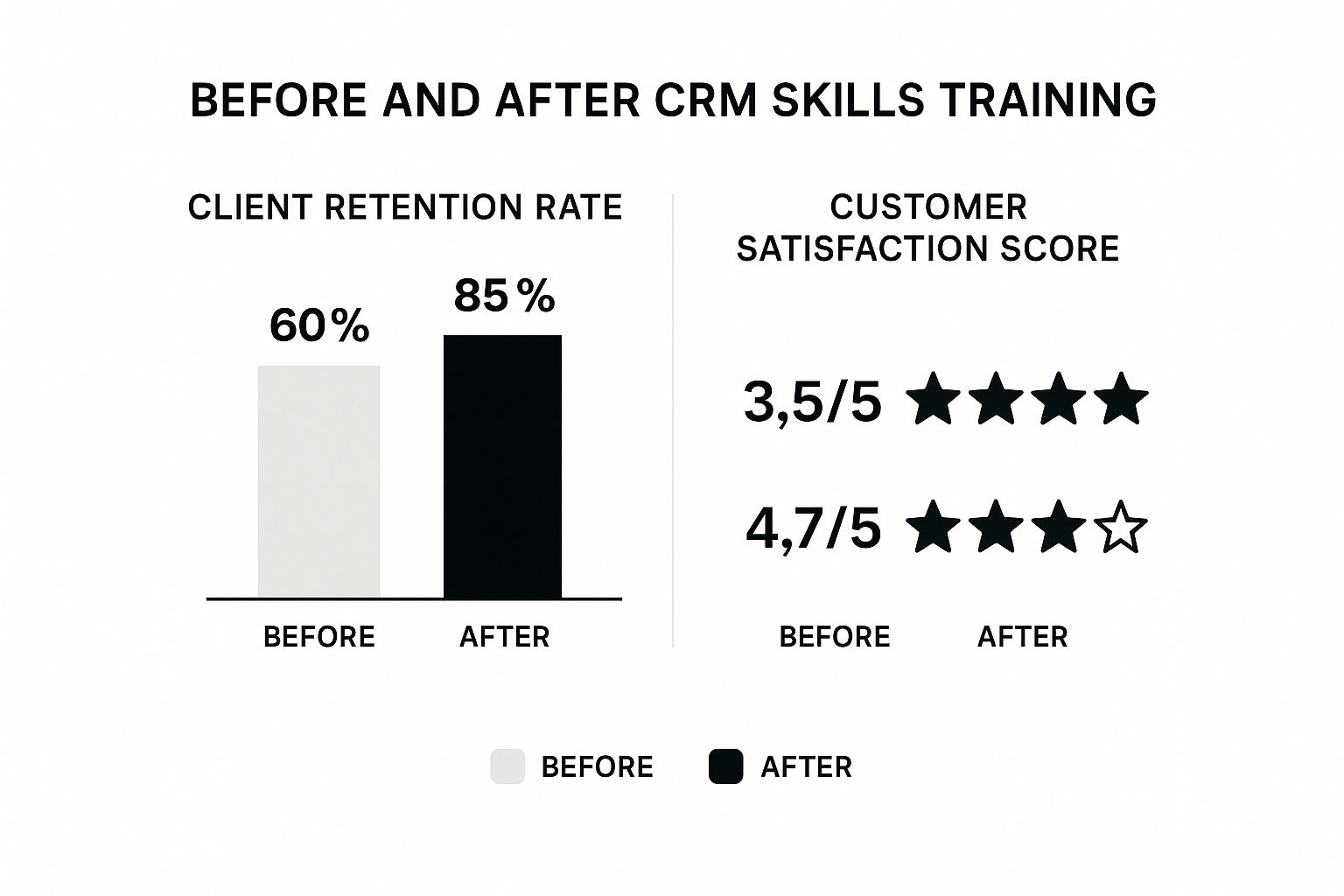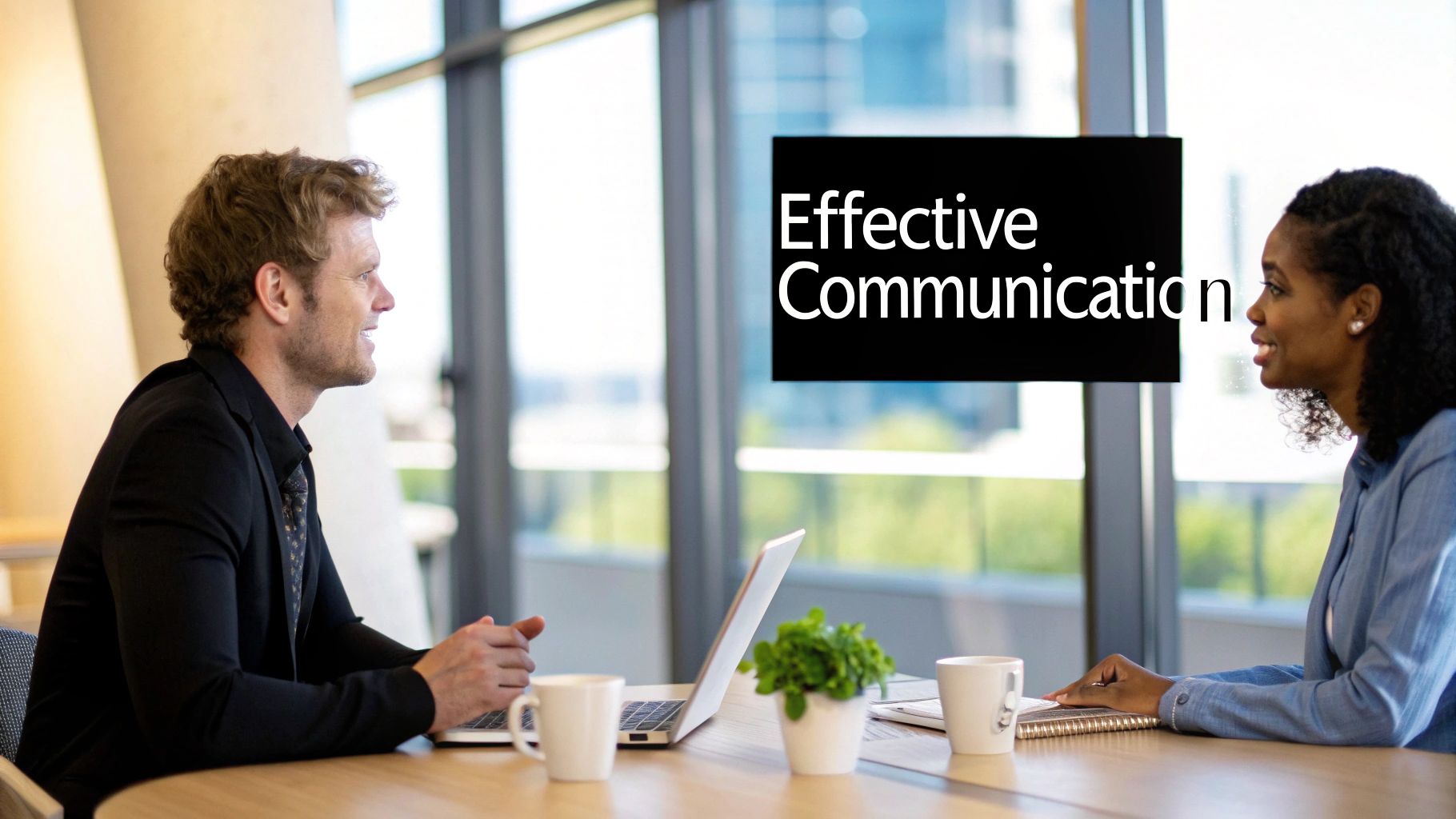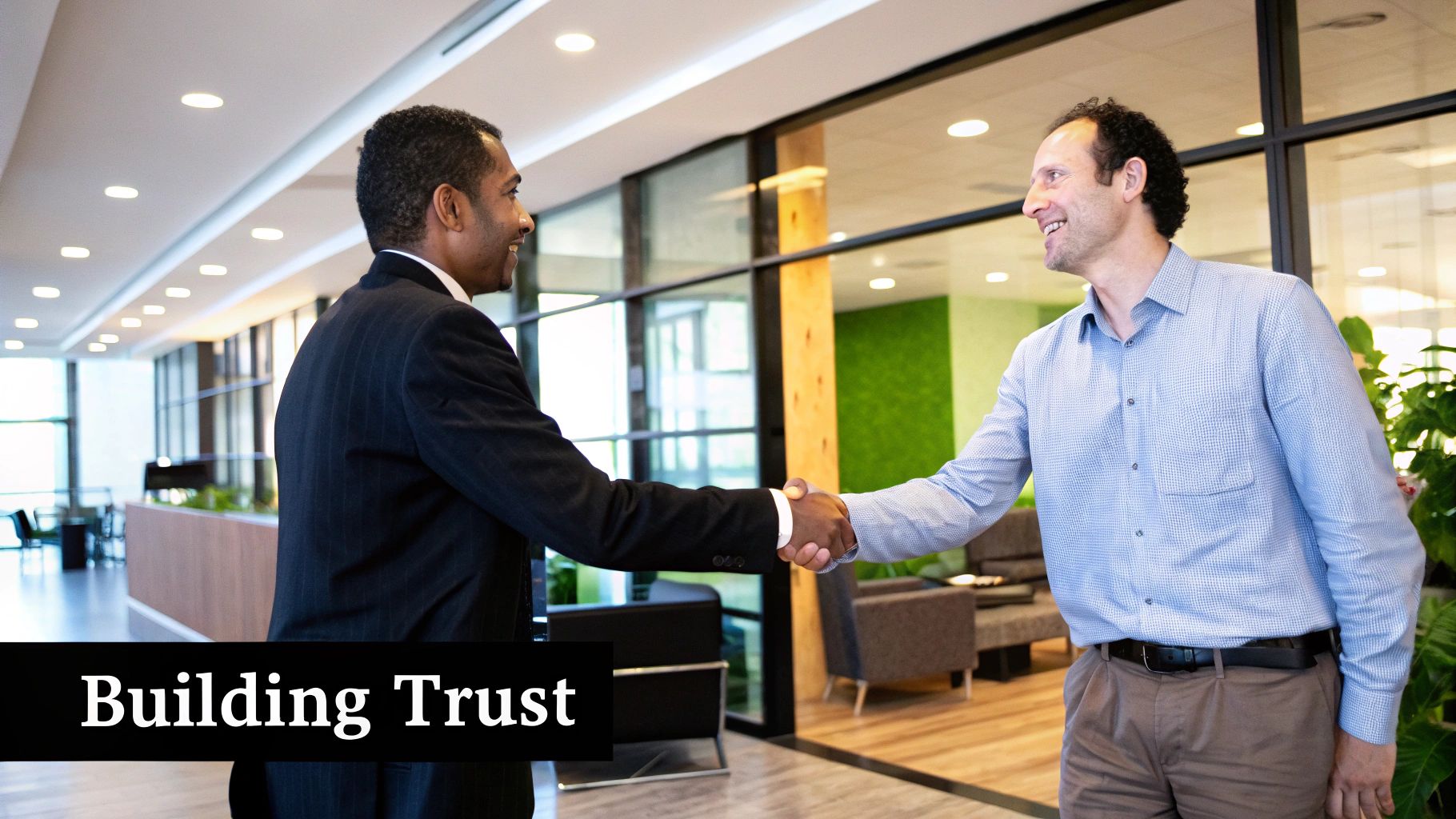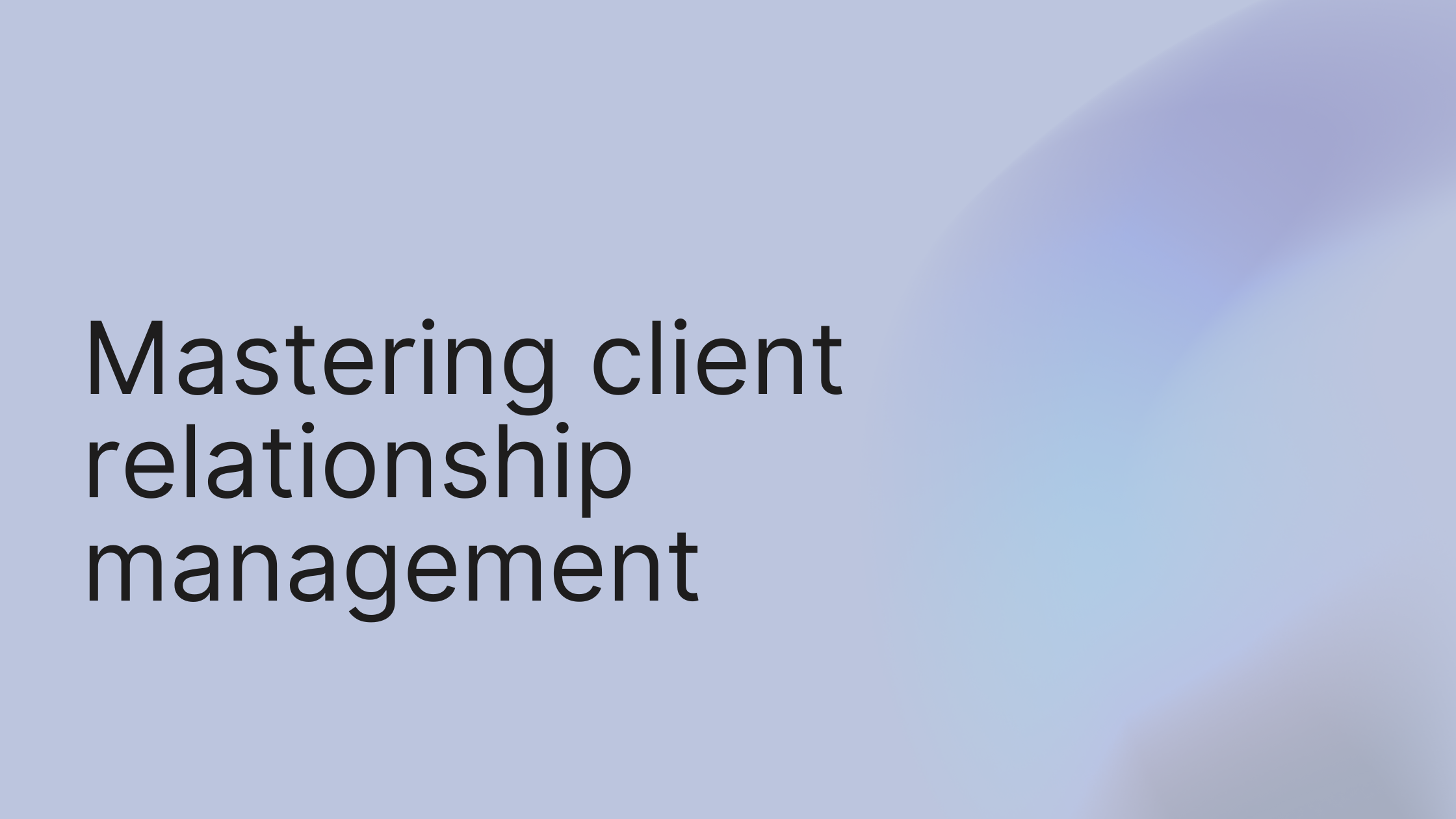Does this sound familiar? You're putting in the hours and hitting deadlines, but some of your most important client relationships feel stuck or at risk of churning. You’re spending your days putting out fires instead of building something meaningful.
Here's a quick win: On your very next client call, after they explain a request, simply say, "Okay, just so I'm crystal clear, you're looking for X to achieve Y, right?" This simple "paraphrase playback" immediately builds alignment and shows you're truly listening. It’s a small step that starts you on the path to proactive partnership.
At its core, client relationship management is all about the strategies and techniques you use to build real trust, deliver undeniable value, and create the kind of loyalty that lasts. It's what separates a one-time project from a true, long-term partnership, and it has a direct line to your client retention and overall business growth.
Why Your Client Relationships Are Stalling
The constant pressure to keep clients happy while also trying to grow the account is exactly where many promising partnerships hit a wall. It's an exhausting cycle, leaving you feeling more like a reactive problem-solver than a strategic partner.
The most powerful change you can make is a simple shift in mindset: stop just reacting to problems and start proactively creating value. This isn't about some vague "soft skills" either; it's a concrete, teachable framework for building the kind of trust that makes a client relationship unbreakable.
From Reactive Firefighting to Proactive Partnership
The table below breaks down this fundamental shift. It’s about moving away from common, reactive habits and embracing proactive strategies that position you as an essential part of your client's success.
| Core Skill | Reactive Approach (Common Mistake) | Proactive Approach (Best Practice) |
|---|---|---|
| Communication | Waiting for the client to ask for updates. | Sharing insights and progress before being asked. |
| Problem-Solving | Fixing issues as they pop up. | Anticipating potential roadblocks and planning for them. |
| Value Delivery | Focusing only on completing the current task. | Connecting deliverables to the client’s larger business goals. |
| Relationship Building | Limiting interactions to project-specific calls. | Seeking to understand the client's industry and challenges. |
By consciously moving from the "Reactive" column to the "Proactive" one, you change the entire dynamic. You stop being a line item on an invoice and start becoming a partner they can't imagine working without.
When you master client relationship management, you fundamentally change how you operate. The real goal is to get ahead of your client's needs, communicate with purpose, and consistently show your value far beyond the day-to-day deliverables. This is how you turn a client who sees you as just another vendor into a partner who sees you as indispensable.
A proactive approach is built on a foundation of deep understanding. You must grasp not only the project's micro-level goals but also the macro-level business objectives your client is trying to achieve. This context is everything.
The impact of this shift isn't just a feeling; it's something you can measure. The data below shows just how much targeted skills training can move the needle on key metrics like retention and satisfaction.

As you can see, investing in these skills pays off, driving a major lift in both keeping clients happy and, just as importantly, keeping them on your roster.
Real-World Use Case: A B2B Agency's Proactive Pivot
A mid-sized digital marketing agency spotted a troubling pattern. Clients seemed happy enough with their campaign results, but they had a bad habit of drifting away after the first six-month contract. Their annual churn rate was hovering around an unhealthy 40%.
Instead of waiting for the "we need to talk" email, the agency decided to get proactive. They rolled out a new type of meeting: a quarterly "Strategy & Foresight" session, which was completely separate from their usual performance reports.
In these meetings, they didn't just talk about clicks and conversions. They presented industry trends, analyzed competitor movements, and brainstormed new opportunities for the client's business—even if those ideas fell outside the current scope of work. This simple change completely repositioned them as forward-thinking partners who were invested in the client’s big picture.
The results were stunning. Within a year, their client retention rate shot up from 60% to over 85%. Even better, they saw a 20% increase in upsells from existing clients who were genuinely excited by the new ideas they brought to the table.
This guide is your playbook for mastering the core skills that lead to these kinds of outcomes. We’ll dig into how you can transform your approach with active listening, proactive problem-solving, and strategic communication, all backed by modern tools that help you centralize crucial insights and empower your entire team.
1. Active Listening: The Foundation of Every Great Client Relationship
Have you ever walked away from a client call feeling like you were speaking two different languages? You were certain you delivered what they asked for, but the feedback comes back that you "completely missed the mark."
This all-too-common gap is where so many client relationships sour. The fix is deceptively simple: stop waiting for your turn to talk and start listening to understand. This single shift is the most powerful client relationship management skill there is.

Actionable Steps for Better Listening
Active listening isn’t passive. It's an engaged process of uncovering the real problem or desire hiding behind their words. Here are step-by-step actions for your next call:
- Step 1: The Paraphrase Playback. When a client explains a complex request, pause and repeat it back in your own words. Say, "Okay, so if I'm tracking this right, the number one priority is X, because you need to solve Y." This confirms you're on the same page and gives them a chance to correct you before a misunderstanding snowballs.
- Step 2: Ask "Why" to Uncover Context. Clients often state what they think they need, but not the underlying reason. If they say, "We need that report by Friday," ask a clarifying question like, "Not a problem. So I can make sure it's perfect, what's the report being used for?" This uncovers the crucial context—like a big presentation to their boss—so you can deliver something that truly helps them succeed.
- Step 3: Log Insights Immediately. After a productive call, don't let those golden nuggets of insight vanish. Use a client workspace in growlio to immediately capture key takeaways and action items. This ensures crucial context is never lost and that the whole team benefits from what you learned. It's an essential piece of a strong onboarding process, which we cover in more detail in our guide to client onboarding best practices.
Pro tip: Track Client Sentiment
Ready for an advanced technique? Create a custom "Sentiment Tracker" field in your CRM or growlio workspace. After each significant client interaction, rate their sentiment on a simple 1-5 scale (1=Frustrated, 5=Thrilled) and add a quick note explaining why. Tracking this over time gives you a powerful, at-a-glance dashboard of the relationship's health, helping you spot a downward trend and intervene before it's too late.
Active listening isn't just a "soft skill"—it's a strategic business tool. When you master it, you lay the foundation for every other part of successful client management.
2. Build Unbreakable Trust with Proactive Problem Solving
Do you ever feel like you're just putting out fires all week? Stop being a firefighter and start being a fire-preventer. This is one of the most critical client relationship management skills you can develop. Real trust isn't built when everything is going perfectly; it's forged when you skillfully navigate challenges before they become problems.
True partners don't just fix things when they break; they see trouble coming. It’s the difference between saying, "Oh no, we have an issue," and, "I've spotted a potential roadblock up ahead, and here’s how we're going to steer around it."

A 3-Step Framework for Getting Ahead of Trouble
Turn reactive chaos into proactive control with this actionable framework:
- Identify Potential Risks: At the start of a project, brainstorm 3-5 potential roadblocks based on past experiences. Did a previous project stall because the client was slow with feedback? Flag that as a risk and build in extra time or a clearer review process from day one.
- Communicate with Transparency: The second you spot a potential risk, tell the client. Being upfront shows you’re a genuine partner watching out for their best interests. For a deeper dive, check out our guide on client communication best practices.
- Present Solutions, Not Problems: This is the game-changer. Never raise an issue without bringing at least one solution to the table. The message you want to send is, "I've identified a possible hurdle, and I've already mapped out a plan to get us over it."
Real-World Use Case: Pre-Empting Churn with Smart Data
A SaaS company noticed a troubling pattern: when an account's product usage started to dip, they were highly likely to cancel within 90 days. Instead of waiting, they got proactive.
They set up alerts in their CRM to flag any account where logins dropped by 30% over two weeks. This didn't trigger a desperate sales call. It triggered a helpful outreach from the account manager: "Hey, I noticed your team hasn't been using the reporting feature much lately. We just dropped a new training video that shows some cool shortcuts. Want me to send it over?"
The impact was immediate. This simple, proactive step cut their voluntary churn rate by 18%. They stopped problems before they started by using data to anticipate needs and offer solutions.
This kind of proactive management is exactly what modern tools are built for. The global market for CRM software is expected to climb from USD 81.20 billion in 2025 to USD 123.24 billion by 2030, with this type of analytics being a huge driver.
When you shift from being reactive to proactive, you fundamentally change your client relationships. You're no longer just a vendor; you become an indispensable partner who actively protects the client's investment.
3. Use Technology to Scale Your Relationship Skills
Ever feel like you’re a fantastic account manager for your top three clients, but everyone else gets a watered-down experience? Your personal skills can only stretch so far. Here's the secret: technology isn't the enemy of a personal touch—it’s the key to delivering it at scale. A smart platform like growlio acts as your team's "second brain," ensuring no detail ever falls through the cracks.

How to Use a CRM to Track the Relationship Itself
A Customer Relationship Management (CRM) system should be more than a sales pipeline. To scale your client relationship management skills, start tracking the qualitative, human side of your partnerships.
- Step 1: Log Communication Preferences. In the client's growlio profile, note if they prefer quick bullet points or detailed paragraphs. This allows anyone on your team to communicate just the way the client likes.
- Step 2: Capture Personal Milestones. Did they mention a family vacation? A quick note in the client record makes it easy to send a thoughtful message later, showing you care about them as people.
- Step 3: Centralize Your Notes. Use growlio's client workspace to create a single source of truth. When every team member can see the same notes, tasks, and communication history, the dreaded "I already told someone this" conversation disappears.
For a deeper dive into integrating artificial intelligence to enhance client interactions and learn proven strategies, consult this complete AI for customer experience success playbook.
Pro tip: Create a "Value-Add" Tracker
Want to take this to the next level? In your growlio workspace, create a custom tag or task list called "Value-Add Moments."
Whenever you or a team member does something that goes above and beyond—like sending a relevant industry article or making a helpful introduction—log it there. During your quarterly reviews, you can pull this list. Suddenly, you have a quantifiable report of all the proactive value you've delivered, powerfully demonstrating the strength of your partnership.
By integrating technology thoughtfully, you can amplify your best relationship-building instincts across your entire client base.
4. Master Strategic Communication and Set Clear Expectations
We’ve all been there. That sinking feeling when a client says, "This isn't quite what we talked about." The gap between what you thought was clear and what the client heard is the silent killer of healthy business relationships.
The fix? Stop assuming and start defining. By establishing a rock-solid communication plan from day one, you build a foundation of clarity that prevents these misunderstandings from ever taking root. It’s one of the most critical client relationship management skills you can develop.
Create a Communication Charter in 3 Steps
During client onboarding, create a simple "Communication Charter" to lay out exactly how you'll work together.
- Step 1: Define the Cadence and Channels. Agree on meeting frequency (e.g., "Weekly 30-min sync via Google Meet") and preferred communication channels (e.g., "Urgent issues via Slack, standard updates via email").
- Step 2: Clarify Key Contacts. Map out the go-to person on both sides for billing, technical issues, and project approvals.
- Step 3: Set Reporting Expectations. Show them a sample report and agree on the specific metrics that matter most to them.
Setting these ground rules upfront removes guesswork. For more, check our guide on how to manage client expectations.
This kind of strategic communication is essential. The global CRM market is projected to hit USD 53 billion in the coming year, with a significant portion of that spend aimed at improving these very interactions. You can find more insights on the CRM market’s growth over at HG Insights.
When you master strategic communication, you stop being just another service provider and become a trusted advisor. It all comes down to being clear, honest, and always one step ahead.
Your Action Plan for Better Client Relationships
https://www.youtube.com/embed/4qUr5QnBRzg
Feeling like you have to overhaul everything at once? That's a recipe for burnout. The secret is to focus on small, immediate changes. Here’s a simple checklist you can use this week.
Your 3-Step Action Plan for This Week
Commit to these three small actions. Each is manageable, but together, they pack a serious punch.
Try the Paraphrase Playback: On your next client call, consciously summarize one of their key requests back to them. Saying, "Just so I'm crystal clear, what you need is..." does wonders for building instant alignment.
Find One Proactive "Value-Add": Send one client something helpful that isn't a billable task. Think of a relevant industry article, a useful tool, or an introduction to someone in your network.
Log One "Human" Detail: After your next client chat, open their record in growlio and add one small, personal detail you learned, like their kid's soccer tournament or their favorite coffee spot. This habit builds a real, human connection over time.
For a deeper dive, exploring these proven strategies for client satisfaction can provide a broader framework for these actions.
This isn't just about being friendly; it's smart business. Think of each of these small actions as a deposit into your "client trust" account. Over time, those deposits compound and build a partnership that is more resilient, loyal, and ultimately, more profitable.
Knowing what to do is only half the battle. The real power comes from actually doing it. And the best way to consistently apply these skills is to have a central hub that supports all your efforts.
Got Questions? We’ve Got Answers.
It's one thing to read about client relationship skills, but it’s another to put them into practice. Let's tackle some of the most common hurdles people face with straightforward, actionable answers.
What’s the Single Most Important Skill to Master First?
If you’re just starting, zero in on active listening. Before you can offer brilliant solutions or build trust, you have to truly hear what your client is saying—and what they aren't saying. Nailing this skill makes everything else, from managing expectations to handling difficult feedback, infinitely easier. It’s the foundation of any real partnership.
How Do I Actually Measure the ROI of Being a Better Partner?
It’s fair to want to see a tangible return. Track a mix of short-term and long-term metrics.
- Leading Indicators (The Day-to-Day Wins): Look for faster issue resolution times, an uptick in positive client comments, or more proactive check-ins initiated by your team. These are the small wins that build momentum.
- Lagging Indicators (The Big-Picture Results): These are the results that show up over the long haul. You're looking for higher client retention rates, a drop in churn, and an improved Net Promoter Score (NPS).
Ultimately, mastering these skills should directly translate into a higher client lifetime value (CLV) and create more opportunities for referrals and upsells.
Can a CRM Genuinely Help with the Human Stuff?
Absolutely. A CRM can't shake a client's hand, but it’s an incredible tool for empowering the human element of your work. Think of it as your team’s shared brain, a place where no important detail—from a client's business goals to their birthday—ever gets lost.
A CRM automates the repetitive stuff, like follow-up reminders, which clears up your mental space. This frees you to focus on what really matters: having strategic, empathetic conversations.
It doesn’t replace the human touch; it creates the time and space needed to deliver it consistently.
You now have the playbook for building stronger, more meaningful client relationships. But knowing what to do is only half the battle; consistency is where the magic happens. growlio gives you the all-in-one workspace to make these skills a core part of your process.
Ready to turn great skills into a reliable system? Start a free growlio account today and build the profitable client partnerships you've been aiming for.
